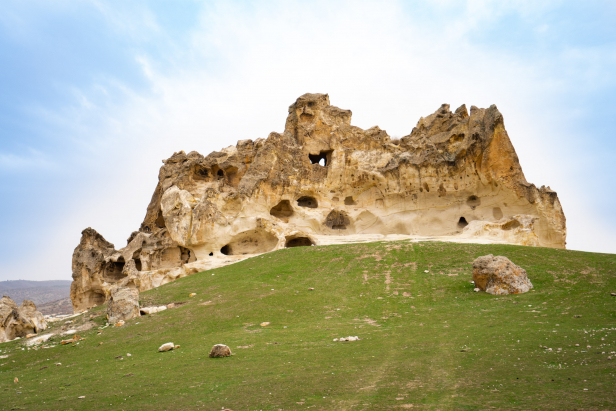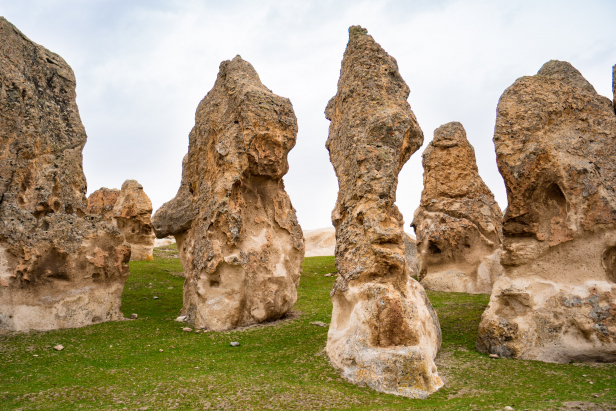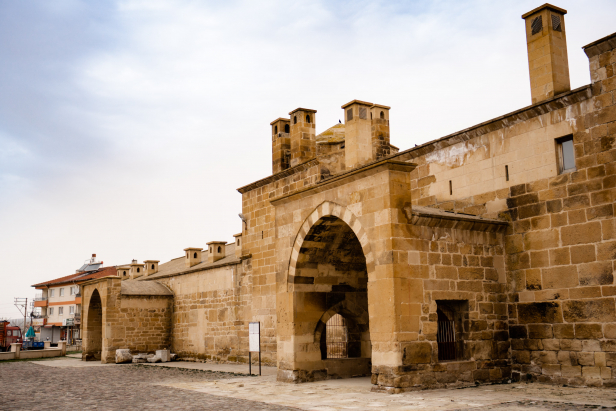The Döğer Caravanserai and Rock Settlement of Asar
Döğer Kervansaray ve Asar Kaya Yerleşimi
/ By Josh
Cost: Free
Great for: Ottoman History, Phrygian History, Silk Road, Caravanserai
While the Town of Döğer is a small backwater today, it has been a site of continual settlement and home to various cultures for thousands of years. The Phrygians, Byzantines, and Ottomans in particular have all left their own unique mark.
Subscribe to The Art of Wayfaring
The town is set in the Phrygian Valley, a region that makes up the historic heartland of the Phrygian culture that developed in the bronze age and then flowered in the early Iron Age following the collapse of the Hittite Empire in the 13th century BC. The landscape is one of pale hills of soft volcanic tuff, worn into wild shapes by wind and rain. The hills surrounding Döğer are filled with fairy chimneys and strange formations rising out of the sheep-cropped grass.
A short drive (or hike) to the north of Döğer is a large cluster of fairy chimneys and the Phrygian Temple site of Asar. The Asar Rock Settlement is a massive protrusion of rock that has been filled with tunnels and chambers. Centuries of erosion has removed walls and exposed the closed rooms. The site was originally built by the Phrygians some time in the 7th or 8th centuries BC, using the space in front of the formation as an open-air temple. There is a Roman tomb here and evidence of a Byzantine settlement dating to the 7th century AD.


On the way to the rock settlement of Asar you will pass by a large collection of fairy chimneys. Here you can see signs of habitation in the form of chimneys, beam holes, and rooflines carved into the rock.
Today the Town of Döğer is best known for its Ottoman Caravanserai, a type of fortress-inn built to protect travellers and caravans along trade routes. The practice of building caravanserai (also referred to as a han) reached a zenith in Anatolia under the Seljuks who built dozens of massive and often ornate caravanserai throughout their territories in Turkey, Iran, and beyond. Döğer Caravanserai is an excellent example of the Ottoman Caravanserai which tended to be less ornate and imposing.
Döğer Caravanserai was built in the 15th century by Sultan Murad II and designed with two sections, each with their own separate entrances. The two sections are accessed through a large door covered by a plain arched awning to keep the snow and rain off the door itself. On the left is the smaller section of the caravanserai, consisting of a single large room, covered with a ribbed vault. This space served as a stable for the animals of the caravans that stayed here.
On the right is a larger section of Döğer Caravanserai: a two storied space of plain vaulted rooms plus a pair of fine domed rooms in the upper storey. This space was used to house the travellers themselves with fireplaces throughout. There is an open iwan in the upper storey between the two domed rooms that served as masjid, or prayer hall.
Subscribe to The Art of Wayfaring
The caravanserai is made of large blocks of local tuff with only the odd piece of obvious spoila (reused architectural pieces from previous buildings). Large portions of the outer walls were recently restored so it’s difficult to say whether these reused marble blocks were originally used in the wall or not. While there is little spoila used in the building there is a small pile of marble pieces carved with various motifs next to the entrance of the stable portion of the caravanserai including a baptismal carved with crosses.

Restoration work was completed in 1993 and the building is used as something of a town hall.
How To Get There
Public Transport
While Döğer is out of the way, you can take a minibus from the city of Afyon right to the village itself. From there you will need to walk if you want to visit the rock cut settlement of Asar.
Car
Drive north out of the city of Afyon on the D665 (Afyon-Eskişehir highway) as far as the town of Gazlıgöl. At Gazlıgöl turn left off of the main highway into the town center then follow the road north to Ihsaniye and on to Döğer. Some of the roads aren’t marked though the signs for the town of Döğer are clear.
For more about car rental and driving in Turkey make sure to read our full drivers guide.
Hiking/Walking
The town of Döğer is a stop along the Phrygian Way hiking trail, a network of trails that wind their way through the Phrygian Valley, the heartland of the Phrygian Culture. For more about how to get to Döğer on foot make sure to read the hiking guides.
Where To Stay
27 kilometers south of Döğer is the town of Gazlıgöl which is home to hotels, resorts, and cabins with geothermal and mineral pools.
Situated 50 kilometers from the city of Kütahya and 45 kilometers from the city of Afyon, these are your best options when looking for hotels. Kütahya has a decent selection of hotels for a non-touristic city while Afyon has the usual selection plus a great selection of mineral pool hotels.
Other Tips
Planning on visiting Döğer? Make sure to check out the rest of the sights of the Phrygian Valley and the sights of Afyon Province.
Subscribe to The Art of Wayfaring
Have any tips or info to add? Spot any mistakes? We’d love to hear about it.

